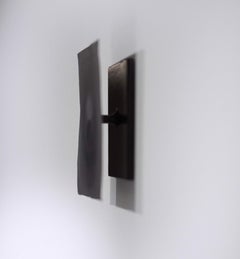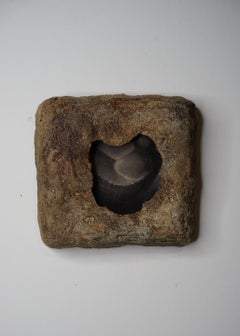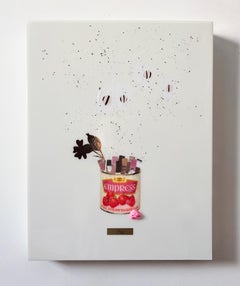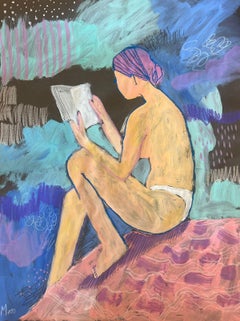Oda Art
to
4
2
4
4
Overall Height
to
Overall Width
to
2
4
4
6,886
3,209
2,514
1,217
3
3
3
2
2
Artist: Oda
Cone Illusion
By Oda
Located in Denver, CO
Cone Illusion
Category
21st Century and Contemporary Oda Art
Materials
Steel
Paper beats Rock
By Oda
Located in Denver, CO
Paper beats Rock
Category
21st Century and Contemporary Oda Art
Materials
Oil, Wood Panel
"Excavation 1" Oil Painting
By Oda
Located in Denver, CO
Oda's (CAN based) "Excavation 1" is an oil painting that depicts dark interior shapes revealed .
Artist Bio/statement:
Corey ‘Oda’ Popp is an emerging Japanese-American contemporar...
Category
2010s Abstract Oda Art
Materials
Oil, Panel, Linen
"Excavation 2" Oil Painting
By Oda
Located in Denver, CO
Oda's (CAN based) "Excavation 2" is an oil painting that depicts dark interior shapes revealed .
Artist Bio/statement:
Corey ‘Oda’ Popp is an emerging Japanese-American contemporar...
Category
2010s Abstract Oda Art
Materials
Linen, Oil, Panel
Related Items
Fabiana : Achy & Ornate
Located in Nashville, TN
This contemporary piece from Danielle Krysa asks the viewer if beauty can be born from the wreckage of whatever each of our personal setbacks may be. The piece was created for Krysa'...
Category
2010s Contemporary Oda Art
Materials
Brass
Girl with a book , 65x50cm
By Aleksandra Mato
Located in Yerevan, AM
Girl with a book
Category
2010s Contemporary Oda Art
Materials
Paper, Pastel, Gouache
Portrait Gentleman Black Coat Orange Sash, Dutch Old Master, Oil on Panel c.1650
By Bartholomeus van der Helst
Located in London, GB
This exquisite portrait of a gentleman depicted in a sumptuous black coat edged with silver and slashed sleeves is an excellent example of the type of portrait fashionable in England and the Low Countries during the 17th century. The confident pose, striking orange sash - the colour of the house of Orange Nassau - and the leather gorget imbue the sitter with a sense of masculinity and power. The profusely decorated costume is of the highest quality and de rigueur of an elite class - the artist has carefully cultivated this portrait to emphasise the sitter’s wealth and standing in the society that he belonged to. The casual pose, with one arm resting on a hip, is much less formal than earlier decades, and it speaks of ‘sprezzatura’ – one’s appearance should not appear laborious, but instead, effortless.
The oil on cradled panel portrait can be dated to circa 1650 based on the hairstyle and the attire - small falling collar, short doublet (doublets reduced in size to just below the ribcage in the late 1650’s), and the type of slashed sleeves with the sleeve seams left open to reveal the white fabric.
The demand for portraits in the Netherlands was great in the 17th century. Bartholemeus van der Helst was considered to be one of the leading portrait painters of the Dutch Golden Age surpassing even Rembrandt as the most sought-after portraitist in Harlaam. The Dutch Golden Age, roughly spanning the 17th century, was a period when Dutch trade, science, military, and art were among the most acclaimed in the world. Dutch explorers charted new territory and settled abroad. Trade by the Dutch East-India Company thrived, and war heroes from the naval battles were decorated and became national heroes. During this time, The Dutch Old Masters began to prevail in the art world, creating a depth of realistic portraits of people and life in the area that has hardly been surpassed. The Golden Age painters depicted the scenes that their discerning new middle-class patrons wanted to see. This new wealth from merchant activities and exploration combined with a lack of church patronage, shifted art subjects away from biblical genres. Still life’s of items of everyday objects, landscapes, and seascapes reflecting the naval and trade power that the Republic enjoyed were popular. The new wealthy class were keen to have their portraits commissioned and many artists worked in this lucrative field. Such was the popularity of art that everyone had a painting, even the humble butcher, and hundreds of thousands of paintings were produced.
By tradition the sitter is Maarten Tromp (1598-1653) who was an Admiral in the Dutch Navy (the reverse of the portrait contains an old handwritten inscription “van Tromp”). Certainly, the distinctive orange sash is similar to those worn by officers of the Dutch army in the Netherlands who served under the Princes of Orange and the House of Nassau. However, it should be noted that the physiognomy differs from other images of Tromp.
Tromp was the oldest son of Harpert Maertensz, a naval officer and captain. He joined the Dutch navy as a lieutenant in July 1622 and was later promoted from captain to Lieutenant-Admiral of Holland and West Frisia in 1637. In 1639, during the Dutch struggle for independence from Spain, Tromp defeated a large Spanish fleet bound for Flanders at the Battle of the Downs, which marked an enormous change - the end of Spanish naval power. He was killed in action during the First Anglo-Dutch War in 1653 where he commanded the Dutch fleet in the battle of Scheveningen.
Gloves were an absolutely vital accessory and the elaborate pair in this portrait are embellished with threads of silk and precious metals and salmon-coloured lining. He wears only one glove and holds the other, providing an opportunity to better display the cuffs and detail on his right wrist and forearm. The gloves are probably made from the most prized leather which came from Spain, in particular from Cordova. Cordovan leather was tanned with a special vegetal process that left it both highly impermeable and divinely soft. King Charles I, posed in a rather relaxed manner for Daniel Mytens’s portrait in 1631, is wearing gloves and boots in matching Cordovan leather. The hide is thick, but you can see just how supple it is from the way the gauntlet dimples and the long boot legs fold over themselves, rippling and wrinkling at the ankles.
Apart from keeping hands warm the use of gloves during the 15th through the 19th centuries were full of symbolism and they were worn regardless of the season. They kept the skin unblemished - soft, smooth hands were considered highly attractive. This combination of necessity and proximity to bare skin made gloves a deeply personal gift and they took on a strong symbolic significance and were regarded as emblematic of fidelity and loyalty for hundreds of years. Such was the importance of their symbolism was that some gloves were never intended to be worn at all. Their luxury made them ideal gifts at court, and so in the 15th and 16th centuries, ambassadors often presented them as symbols of loyalty.
Until the mid-19th century, it was customary to give gloves as tokens to guests at weddings and to mourners at funerals. Gentleman often gifted their bride-to-be with a pair of gloves (the obligatory gift) and were handed over at the betrothal and put on display before the wedding took place. It was probably their direct contact with the skin that led to the eroticism of gloves. Not only were pairs often exchanged between lovers, but from the 16th to the 18th centuries, it was common practice to remove one glove and give it as a gift to a favourite. The idea of the item being presented still warm from the wearer’s hand is certainly suggestive. Following the death of King George IV, his executors purportedly found over a thousand mismatched ladies’ gloves among his possessions.
The sentiment of a 17th-century poem reveals the popularity of the practice: “Come to our wedding to requite your loves / Shew us your hands and we’ll fit you with gloves.” Such generosity might be pricey for the hosts, but gloves of varying quality could be offered depending on the status of the recipient. Pairs made with the finest Spanish leather might be reserved for immediate family, while coarse sheep’s leather could be distributed among the servants and tradesmen. The apportioning of quality according to class provided a very clear message of the gloves’ intended use. For refined guests, they were decoration; for the lower classes, they were functional.
Bartholomeus van der Helst...
Category
17th Century Old Masters Oda Art
Materials
Oil, Wood Panel
H 38.59 in W 31.89 in D 2.76 in
Beach, 70x50cm
By Aleksandra Mato
Located in Yerevan, AM
Beach
70x50 cm
Category
2010s Contemporary Oda Art
Materials
Paper, Pastel, Gouache
Abstract Art, Contemporary Art, Colors, Contemporary Art
By Lisa Pressman
Located in Houston, TX
This painting is being sold on consignment by the gallery for an estate. The artist is known for her abstract paintings. She is also an instructor in the arts. More information avai...
Category
2010s Abstract Oda Art
Materials
Linen, Oil, Wood Panel
Portrait of a Lady Diana Cecil, Countess of Elgin c.1638, Manor House Provenance
Located in London, GB
Titan Fine Art present this picture which formed part of a historic collection of an English aristocratic family, Lord and Lady Sandys at their magnificent baroque and Regency Grade-...
Category
17th Century Old Masters Oda Art
Materials
Oil, Wood Panel
H 18.9 in W 16.15 in D 1.58 in
Notes And Things - 6"x12", Black, White, Pink Abstract Painting
By Andrea Stajan-Ferkul
Located in Mississauga, Ontario
So little with so much to say. This expressive abstract painting invites the viewer to interpret an untold message. Emphasis is on simplified composition with the use of paint, paper...
Category
2010s Contemporary Oda Art
Materials
Canvas, Pastel, Acrylic
H 6 in W 12 in D 0.75 in
Mixed Media, pencil-signed and with artist bio
Located in Clinton Township, MI
"Untitled" Mixed media piece by the artist KENT KALMAN PACHUTA. Mediums used include color pencil, graphite, pastel and powdered pigment on thick paper. The piece measures approximat...
Category
Late 20th Century Oda Art
Materials
Pastel, Mixed Media, Color Pencil, Graphite
"Waterfall with Spray" Small Landscape of Waterfall and Rocks, Beautiful Light
By Kimberly MacNeille
Located in Wellesley, MA
"Waterfall with Spray," 12 x 12 x 3/4 Inches, is a beautiful small painting of Niagara Falls, part of a larger series of 12 x 12 inch waterfall paintings as seen from various vantag...
Category
2010s American Realist Oda Art
Materials
Wood Panel, Oil
OX 68
By Daniel Brice
Located in Phoenix, AZ
oil and acrylic on linen over panel
In his abstract paintings and prints, Daniel Brice explores both the physicality and the intellectual and emotional resonance of color. Based in ...
Category
2010s Abstract Geometric Oda Art
Materials
Linen, Oil, Acrylic, Panel, Wood Panel
Promesse I & II / Diptych - Oil on Linen
By Frédéric Choisel
Located in Burlingame, CA
Promesse I & II ( Diptych) is a magnificent abstract oil painting of ephemeral clouds floating on an elegant deep blue sky . A unique view of clouds at twilight, in rich shades of...
Category
21st Century and Contemporary Abstract Impressionist Oda Art
Materials
Linen, Oil, Wood Panel, Pigment, Canvas
"Waterfall with Spray and Shrubs" Small Landscape with Waterfall, Sky, Greenery
By Kimberly MacNeille
Located in Wellesley, MA
"Waterfall with Spray and Shrubs," Oil on Panel, 12 x 12 x 3/4 inches, is a meticulously painted rendition of a waterfall on a summer day. The top half of the painting is dominate...
Category
2010s Photorealist Oda Art
Materials
Oil, Wood Panel
Oda art for sale on 1stDibs.
Find a wide variety of authentic Oda art available for sale on 1stDibs. You can also browse by medium to find art by Oda in oil paint, paint, panel and more. Much of the original work by this artist or collective was created during the 21st century and contemporary and is mostly associated with the abstract style. Not every interior allows for large Oda art, so small editions measuring 5 inches across are available. Oda art prices can differ depending upon medium, time period and other attributes. On 1stDibs, the price for these items starts at $300 and tops out at $475, while the average work can sell for $425.





